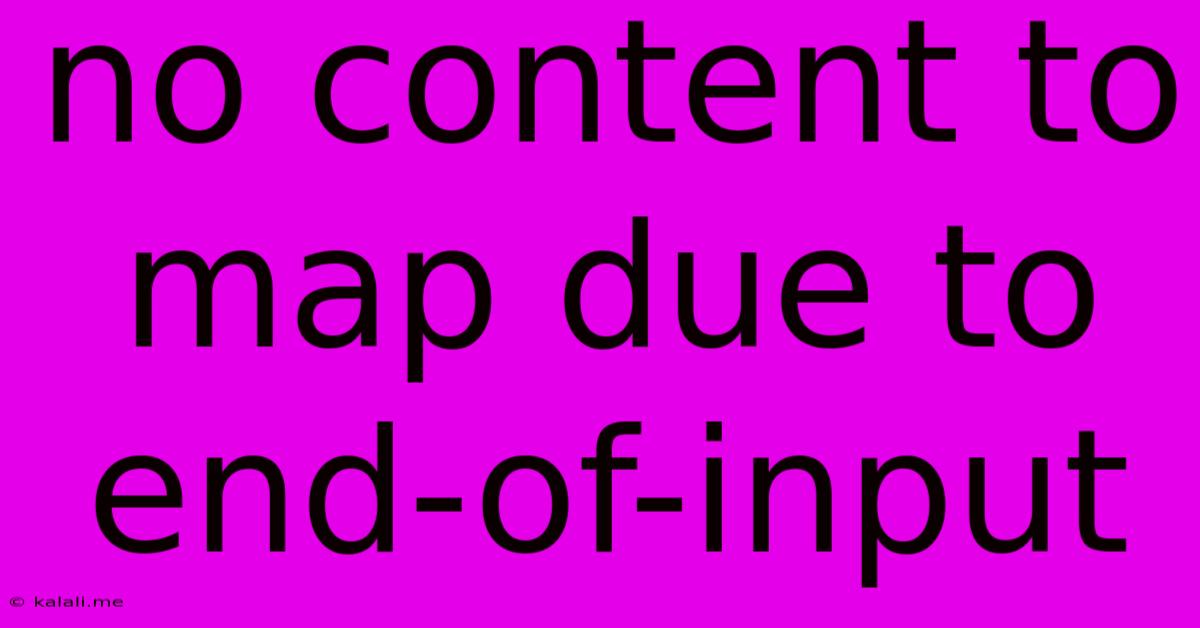No Content To Map Due To End-of-input
Kalali
May 25, 2025 · 3 min read

Table of Contents
Decoding the "No Content to Map Due to End-of-Input" Error: Troubleshooting and Solutions
The dreaded "no content to map due to end-of-input" error message can strike fear into the hearts of developers and data analysts alike. This cryptic error usually signifies a problem with data parsing or processing, indicating that the system encountered the end of a data stream before it could completely process the expected information. This article will explore the common causes of this error, provide practical troubleshooting steps, and offer effective solutions.
Understanding the Error Message
The error essentially means your program or script reached the end of a file or data source without finding all the data it needed. This often occurs when dealing with structured data formats like XML, JSON, or CSV files, but it can also crop up in other contexts where data streams are involved. The lack of expected content implies a mismatch between what your program anticipates and what's actually provided.
Common Causes and Troubleshooting Steps
Several factors can trigger this error. Let's break down the most frequent culprits and how to debug them:
1. Incorrect File Paths or URLs
- Problem: The most basic reason is that your program is trying to access a file or URL that doesn't exist, is misspelled, or is inaccessible due to permission issues.
- Troubleshooting: Double-check the file path or URL for typos. Verify that the file actually exists in the specified location and that your program has the necessary read permissions. Use debugging tools to print the path or URL being used to ensure it's correct.
2. File Corruption or Incompleteness
- Problem: The data file itself might be corrupted or incomplete, leading to a premature end-of-input. This is common with downloaded files or files transferred across networks.
- Troubleshooting: Try downloading or transferring the file again. Use a file integrity checker to verify the file's integrity. Look for any obvious signs of corruption within the file itself (truncated lines, unusual characters, etc.).
3. Data Format Issues
- Problem: If dealing with structured data (XML, JSON, CSV), errors in the data's formatting—missing tags, incorrect delimiters, unexpected characters—can prevent the parser from reaching the expected end.
- Troubleshooting: Manually inspect the data file for any formatting errors. Use a validation tool specific to the data format (e.g., an XML validator) to check for syntax errors. Correct any identified errors in the data file.
4. Programming Errors
- Problem: Bugs in your code might lead to incorrect data reading or processing, causing the program to hit the end-of-input unexpectedly. Incorrect loop conditions or file handling procedures are common suspects.
- Troubleshooting: Carefully review your code, paying close attention to file reading and parsing routines. Use debugging tools (printers, debuggers) to step through the code and inspect variable values. Utilize logging to track the program's progress and pinpoint where the error occurs.
5. Network Connectivity Problems
- Problem: If the data source is remote (e.g., a web service), network issues can interrupt the data stream, leading to a premature end-of-input.
- Troubleshooting: Verify your network connection. Check for any network outages or firewall restrictions that might be blocking access to the data source.
Preventing Future Errors
Proactive measures can minimize the likelihood of encountering this error:
- Robust Error Handling: Implement comprehensive error handling in your code to gracefully manage potential issues, including checking for file existence and handling exceptions during file I/O operations.
- Data Validation: Validate data as it’s being read and processed to detect errors early.
- Input Sanitization: Sanitize user input to prevent malicious or unexpected data from causing problems.
- Regular Testing: Thoroughly test your code with various inputs and edge cases to identify and fix potential problems before deployment.
By systematically investigating these potential causes and applying the suggested troubleshooting steps, you can effectively diagnose and resolve the "no content to map due to end-of-input" error and ensure the smooth operation of your programs and applications. Remember that meticulous attention to detail in both data handling and code implementation is key to preventing this frustrating error.
Latest Posts
Latest Posts
-
What Is 20 Percent Of 800 000
Jul 12, 2025
-
Words That Start With Y In Science
Jul 12, 2025
-
Prevent An Expressway Emergency By Merging Without
Jul 12, 2025
-
How Many Grams Of Sugar In A Pound
Jul 12, 2025
-
7am To 11am Is How Many Hours
Jul 12, 2025
Related Post
Thank you for visiting our website which covers about No Content To Map Due To End-of-input . We hope the information provided has been useful to you. Feel free to contact us if you have any questions or need further assistance. See you next time and don't miss to bookmark.